The area designated �Running Springs� includes Running Springs,
Fredalba, Arrowbear Lake, Snow Valley and Green Valley Lake.
Running Springs, located at the intersection of State Highway 18 and State
Highway 330, was once known as Hunsacker Flats. It is widely held that the name
came from Abraham Hunsacker, a member of an early Mormon Battalion.
Improvements of both state highways by the early 1920�s, resulted in the area
being discovered. Restaurants, lodging and commercial land development �
including a lake � brought the �flatlanders� to the area.
Fredalba is located approximately two miles below Running Springs.
The Smiley brothers, Alfred and Albert from Redlands, purchased land in the area
in 1895. They initially named the 262 acres - Fredalba Park, a name presumably
derived from a combination of Alfred and Albert. The Smiley brothers envisioned
a resort area where the folks from Redlands would come and enjoy the mountains.
Fredalba was also the site of the Brookings Mill and lumberyard.
Arrowbear Lake is located on State Highway 18 east of Running Springs.
The community of Arrowbear Lake dates to 1924 when M. P. Carlock leased a
portion of former Brookings Sawmill land, dug a 5-acre lake, and developed the
area. The post office dates to 1927 and was initially �Arrow Bear�. The name was
changed to Arrowbear Lake a year later.
Snow Valley is located on State Highway 18 east of Arrowbear Lake.
This area was known in earlier days as Fish Camp. Initially isolated, because the
Rim of the World Drive originally went through Green Valley, the area was
known only to fishermen and hunters. However, in 1923 when the Rim of the
World Drive was realigned to a more direct route to Big Bear Lake, the new
alignment sent the road through this valley. Soon Fish Camp grew into a busy
roadside resort operated by the Swetkovich brothers. They also operated a
small lumber mill there known as Six-Bits Lumber Mill � Swetkovich being
somewhat difficult to remember. The hillside was ideal for winter sports and by
1934, tobogganing and skiing had taken hold. In 1937, the Arrowhead Springs
Corporation began to develop the slopes for skiing and tobogganing and
named it Snow Valley. In 1940 when the Arrowhead Springs Hotel was
declared bankrupt, Johnny Elvrum, former United States ski jump champion,
obtained the sports complex. Shortly after WWII Johnny began an expansion
program that resulted in Snow Valley becoming one of Southern
California�s leading winter sports centers.
The dam at Green Valley Lake was completed in August of 1926.
With the completion of the dam - the reservoir and water system, along with
the �new� lake and the Top O� the World Club clubhouse was presented to the
propert y owners as a gift from the developers, DeWitt-Blair Realt y Company.
Click on images below to enlarge!
|
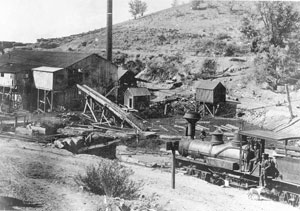 |
Brookings Lumber Mill. In 1890, James and C.D.
Danaher purchased 1600 acres of land from David Seely.
Shortly after the purchase they organized the Highland
Lumber Company and in 1892, the first sawmill in the
Fredalba area was completed. In 1899, their holdings in
Fredalba/Running Springs were sold to the Brookings
Lumber Company. By 1915, the Brookings Company had
moved to Oregon and the mill was dynamited into scrap. |
|
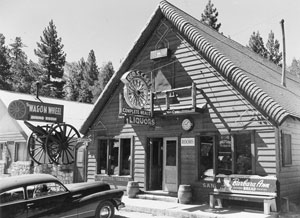 |
Wagon Wheel. In 1930, Percy Ball purchased these
wagon wheels at an auction in Holcomb Valley north of
Big Bear. He set them up at his new cafe in Running
Springs on the Rim of the World Drive, where they
became his trademark and provided the name for the
famous Wagon Wheel Cafe. A few years later, Ball sold to
George S. Case, who owned the cafe for 11 years before
selling to Bill and Juanita Baker in 1949. The Wagon
Wheel was torn down in the 1970's. |
|
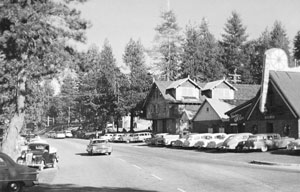 |
Main Street Running Springs. This circa mid 1950�s
photo shows the main street in Running Springs looking
east. The famous Wagon Wheel restaurant is on the right
in the foreground. It was torn down in the mid 1970�s and
a vacant lot still remains where this once proud icon of
Running Springs once stood. |
|
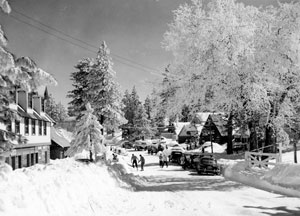 |
Running Springs Winter Wonderland. This early 1950�s
image again shows the main street through town. Again,
the famous Wagon Wheel restaurant is on the right. The
scene shows the natural beauty of the town in winter. |
|
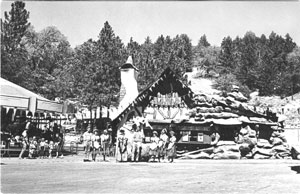 |
Enchanted Forest. Pictured here is the Hobbit-like snack
bar at the Enchanted Forest amusement park. The park
also included a �Castle in the Black Forest� which was an
authentic masterpiece of European Chivalry. This
spectacular and colorful setting was located on Highway
330 a few miles below Running Springs. The park opened
in 1961, but by 1964 the enterprise failed. A post office
that was located there closed on March 15, 1964. |
|
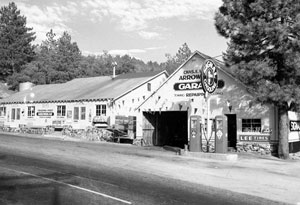 |
Arrowbear Trading Post. The Arrowbear Trading Post
was located on State Highway 18 in Arrowbear. In the
1990�s this was the location of The Czech Inn Restaurant
and earlier in the 1980�s, the Mountain Gourmet. More
recently it was the location of Blondie�s Bar and Grille.
The garage in the picture is gone. The proprietor of the
Trading Post and garage was Charles E. Hawes. The
Trading Post housed the Arrowbear post office, store
and caf�. |
|
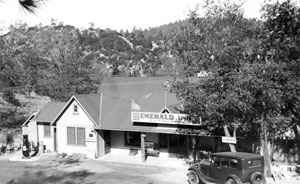 |
Emerald Inn. The Emerald Inn was located on State
Highway 18 at Deep Creek Dr. D.A. McGlinchey was the
proprietor in the 1930's. He was a salesman for Frank
Seccombe Real Estate. It is believed he later sold the
restaurant to Frank Holland, who also owned Rim Lumber
in Rimforest. The original building was partly destroyed by
fire. The Arrowbear Lake post office was also located here
and McGlinchey was postmaster from 1932 until 1943. |
|
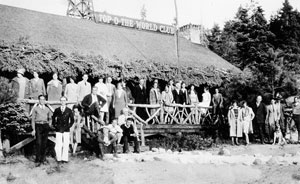 |
Top O the World Club House Postcard. The messages
on the postcard shown here read, �Happy throng at Top
O� the World Club,� and �Green Valley Lake May, 1928�.
The �Top O� the World Club� opened on Memorial Day
1925. The opening featured a carnival and general fiesta �
pancakes and coffee were served, �free of charge�.
A cowboy band was also in attendance. |
|
|
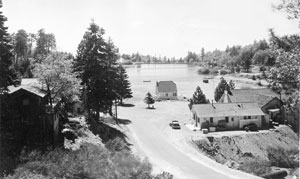 |
Green Valley Lake. It was announced in May of 1925
that 60 workmen are rushing to complete the big dam that
will store water for the new Green Valley Lake. C. F.
DeWitt, one of the developers, also announced the
hauling-in of material for the construction of an artistic
three-room stucco boulder lodge on the shore. The dam at
Green Valley Lake was completed in August of 1926. |
|
 |
Green Valley Lake In Summer. This view shows a myriad
of cars parked at Green Valley Lake in the summer during
the 1950�s. No power boats were allowed but the
public could swim and rent paddle boards. The lake remains
a popular destination. |
|
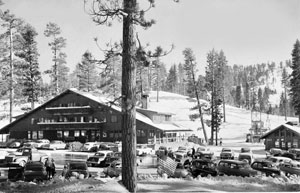 |
Snow Valley. The Snow Valley ski resort area is depicted
in this mid 1950�s image. During winter, the resort is
opened to snow skiing and snow boarding. Located just a
short distance from Running Springs, this is one of the
closest ski resorts to the lower Inland Empire. |












 Home
Home